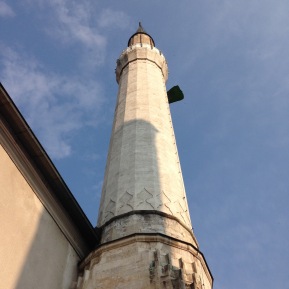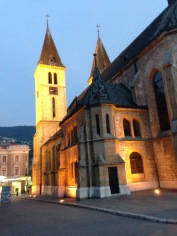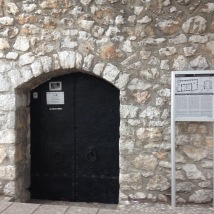Where to begin? It is now our last night here (though, as with Belgrade, fortunately we will be passing through again once C and K get here). I have never actually been to Sarajevo before and truly didn’t know what to expect. But what we initially found defied expectations and then continued to toss us back and forth, forth and back.
I was prepared to find a city pretty much still in shambles. After all, much of the Berlin I had seen (especially in the East) when I lived there 30 years after WWII was still a mess. I had seen footage of Sarajevo during the Bosnian war of the 1990’s — it had been under siege for 1,424 days, from April 1992 till February 1996 — the longest siege of a major European city in recent history; three times longer than the Battle of Stalingrad and more than a year longer than the Siege of Leningrad during WWII. “Why do you want to go there?” a friend of mine in Miami asked me, “it will be so depressing.”
But our initial impressions were anything but depressing. During the drive from the airport we saw many new buildings (wars have a way of speeding up urban renewal…), and when we arrived at our airbnb apartment (via extreme San Fransisco-eque streets,  unbelievably narrow to boot — I now declare myself having moved from the novice to the intermediate category of foreigner-driving-in-Europe!), we were warmly greeted by the
unbelievably narrow to boot — I now declare myself having moved from the novice to the intermediate category of foreigner-driving-in-Europe!), we were warmly greeted by the  father of the apartment’s owner who not only carried my suitcase up the two flights of stairs, but also gave us fresh fruit (and there is no fresh fruit that can compare to that in this part of the world, bar none!) and showed us the semi-stocked refrigerator. As a sign of respect, we removed our shoes on entering the apartment and have continued to be vigilant about not wearing them inside. On our third morning, S (the owner’s dad) knocked on our door with a plate of amazing pastries, baklava and such, explaining that it was in celebration of Bajram (or Eid), the day after Ramadan ended.
father of the apartment’s owner who not only carried my suitcase up the two flights of stairs, but also gave us fresh fruit (and there is no fresh fruit that can compare to that in this part of the world, bar none!) and showed us the semi-stocked refrigerator. As a sign of respect, we removed our shoes on entering the apartment and have continued to be vigilant about not wearing them inside. On our third morning, S (the owner’s dad) knocked on our door with a plate of amazing pastries, baklava and such, explaining that it was in celebration of Bajram (or Eid), the day after Ramadan ended.
After we settled into the apartment, we ventured forth into the old part of town, “Bascarsija,” (“Bash-char-sheeya”) which is a pedestrian zone teeming with life — restaurants, coffee shops, an indoor bazaar which reminded me of the sukh in the old part of Jerusalem — and so much more. This part of town contains both the historic Gazi Husrev-begova džamija (mosque), the old Orthodox church of Archangels Michael and Gabriel , the Sarajevo Synagoge, and the Roman Catholic Cathedral of Jesus’ Sacred Heart — all within a few hundred meters of each other. The city, and especially the old city (“Stari Grad”) still maintains some echoes of the multi-ethnic, multi-cultural microcosm it once was. I had hoped to see the Sarajevo Haggadah, memorialized in Geraldine Brooks’ novel People of the Book, but sadly the National Museum in which it is housed has been closed since 2012 due to on-going disputes about funding. Ironically, this museum remained open during the war, surviving without major damage. Hopefully the issues will be resolved so that this historical treasure will once again be available to the world.
 During our four days here we continue to be gob-smacked by the food — the single disappointment was succumbing to our hunger that first evening and settling for pasta. “It tastes like they opened a can of Chef Boyardee,” S. observed. Note to self: wait until we get to Italy at the end of this journey to order pasta again…!
During our four days here we continue to be gob-smacked by the food — the single disappointment was succumbing to our hunger that first evening and settling for pasta. “It tastes like they opened a can of Chef Boyardee,” S. observed. Note to self: wait until we get to Italy at the end of this journey to order pasta again…!
Strolling through Bascarsija that first night (as we actually ended up doing every night thereafter) was a feast for all the senses — sight, smell, sound, taste, and touch (just had to touch many of the wares in the various stalls of the indoor bazaar). As we topped off the evening with a rice pudding style dessert, washed down with tea and the local Bosnian mineral  water we even got to witness a very lively alteration between an older man and several feisty adolescents. As much as I could figure out it was something about the kids’ being on his roof and doing something untoward (drinking? smoking? throwing things?). The police were ultimately summoned and finally some parents came and took the young offenders home. Kids’ shenanigans are kids’ shenanigans pretty much all over the world.
water we even got to witness a very lively alteration between an older man and several feisty adolescents. As much as I could figure out it was something about the kids’ being on his roof and doing something untoward (drinking? smoking? throwing things?). The police were ultimately summoned and finally some parents came and took the young offenders home. Kids’ shenanigans are kids’ shenanigans pretty much all over the world.
On our second day we visited with representatives of two different peace-making/reconciliation groups and yesterday we went to Srebrenica and the Potocari cemetery and memorial. I will write about those shortly, but first I wanted to share initial impressions of a city which seems to have risen from some pretty horrendous ashes.





I continue to follow these posts with rapt attention. All I ever knew of Sarajevo was Archduke Ferdinand and his wife Sofie, and of course the assassin.
LikeLike
Haven’t even been to the site of that yet — will go when we come back at the beginning of August with C and K. So nice to have a “do-over” in this amazing city!
LikeLike
Looks and sounds absolutely amazing! How wonderful and heart warming that you were offered morning pastries on Eid! How cool is that? Sounds like you may have many thank you cards to send after this trip! And one of the tallest minarets in the Ottoman Empire? I had no idea! Wow!
LikeLike
I’m glad to hear all this Willie. And your photos are wonderful! Thanks!
LikeLike
Thank you, Robin!
LikeLike
Fascinating, Willie, to hear what’s emerging after so much war. Description of major religious sites so near, makes it sound like Jerusalem & made the terrible clashes a bit more comprehensible, though still terribly sad … someone always wants to be “right.”
LikeLike
Thanks, Jeannette!
LikeLike
Exciting for us to be following you from home while you are away exploring.
LikeLike
Thanks, David!
LikeLike
Nik’s comments part I:
So nearly three months after we met in Belgrade I finally found time to read your blog entries and will offer some comments. I will start with this one, because it seems to me that a visit to Sarajevo was the focal point of your adventure – geographically but also emotionally. I must say that i am very impressed by your efforts to learn about what happened there, and to help – and I do think that people like you who try to bring a degree of empathy, love, understanding and care to that unfortunate land contribute to the healing. So my hat off to you!!
The last time I visited Sarajevo was in 1972 almost exactly a year before leaving for California. I did not return to that part of the world until exactly 30 years later, and then it was to visit what little of our family is still left in Belgrade. What I remember of Sarajevo was that it was an almost magical place, where three civilizations managed to coexist for centuries, without major internal conflicts (important exception being WWII). It was a city where Austro-Hungarian edifices painted a royal yellow rise next to blocks of middle eastern single story ramshackle homes and bazaars. On top of that there was, in the early 70’s, a substantial contribution to the city landscape of the socialist style of concrete architecture. ( I believe that the Brits call that style Brutalism – for a reason.) Places of worship similarly reflected this diversity – a mosque next to an Orthodox church next to a Catholic church. People were friendly, open, and extremely hospitable.
The Communist regime relentlessly emphasized the “Yugoslav” background and ethnicity of people – they would point to mixed marriages of say a Bosnian Muslim and a Croat, or a Serb and a Croat, and point out that children of these marriages were the true Yugoslavs. Since these inter marriages happened more in Bosnia than any place else ( to my knowledge), Bosnia, and Sarajevo as its Capital, were showcased as the true home of the new Yugoslavia, transcending the old national divisions. When Communism fell, the ease with which this idea also fell apart and the old national identities coalesced into old patterns is partially due to the Communists forcing the Yugoslavism down the people’s throats whether they liked it or not. And some did like it, as hard as it is for us to believe. There is a lost generation of children (they are now in their 50s and 60s) born of mixed marriages who had genuine trouble identifying with either the Serbs, Croats or Bosnian Muslims. I had friends in high school who genuinely felt Yugoslav and could not, even if they wanted to, identify with any of the other nationalities. The Sarajevo Winter Olympics in 1984 were supposed to present to the world this new country and these new people rising out of nationalist divisions and hatred. Well, we all know how it all ended.
I have recently been reading several new books about the history of Yugoslavia, both the recent disintegration of the country, the wars in Bosnia and Kosovo, as well as the period in the immediate aftermath of World War I and the creation of the original country (which was then called Kingdom of Serbs, Croats and Slovenes, to be renamed Yugoslavia in 1929.) What makes these readings fascinating, is that finally, some good, fact based historical research is being done by the academics and historians, using data unavailable until 1992 and the fall of Communism. True, there are still many revisionist histories being written on all sides, and it is a major effort to sift through the rubble of misinformation and half truths, but wasn’t that always the case when dealing with Eastern Europe?
So one of the interesting conclusions by at least two historians ( I will give you references if you are interested) is that the official, government sanctions and encouragements of Yugoslavism, and attempts to replace the old national identities, pre-date the Communist assent to power in 1945. The Serbian Karageorgevich royal dynasty which ruled the new country after WWI, attempted to promote, encourage and otherwise emphasize the new concept of a Yugoslav nation over the old national division into Serbs, Croats etc. This was done evidently out of a genuine belief in the idea, as well as the only logical way to keep the new country together. Needless to say it did not work from day one. It was a great idea on paper (concocted by a bunch of mostly Croat nationalists in the coffee houses of Vienna in the 19th Century), but as a realpolitik it did not and could not work. Croats, Slovenes and Bosnian Muslims saw it as an attempt by the Serbs to consolidate power by diminishing their national identity and Serbs saw it as an affront to their national pride. Communist which took over in 1945 simply continued with the same approach, but also put a clamp on any discussions and dissent, however well meaning. So when the lid was taken off in ’92, all the pent-up frustrations exploded all at once. (Excuse the mixed metaphors, and bad grammar.)
You can of course go back even further in history than 1918 to find the roots of what ultimately happened there, but a simple fact is that as far as Serbs and Croats are concerned, prior to 1918 (when they actually started living together) there have never been any conflicts between these two peoples. Of course neither had a country of its own for centuries (Serbs were part of the Ottoman Empire, Croats of the Hungarian and then Austro-Hungarian. ) The Serb – Muslim and Croat-Muslim conflicts are a different matter, of course. One of the more bizarre notions concocted mostly by Serbs since 92, is to call the Bosnian Muslims “Turks.” This is preposterous because ethnically Bosnian Muslims are mostly Slavs who were Islamized (is that a word?) in the middle ages during the Ottoman Turk occupation of the Balkans. Of course there were Turks living there, and of course there may be Turkish blood in the veins of all of use who hail from there, but that is not a scientific basis from labeling an entire population as Turks. (Incidentally it is supposed to be an insult.)
So what happened in Srebrenica for example, is seen in Serbian nationalistic circles, in part as a justified revenge on the Turks who oppressed the Serbs for all those dark 500 years of Turkish occupation. Believe it or not.
Let me end on a more pleasant childhood memory of Sarajevo in the late 1950s and early 1960s. My family (Mom, Dad and I) started going to the Dalmatian coast on Summer vacations in 1958 or 59. That meant a trip from Belgrade to Dubrovnik. My Dad bought his first car, a used German Opel Olympia (grey) around 1957, and in either 58 or 59 we made our first trans Balkan trip to the coast. At that time there were no paved roads between Belgrade and the Dalmatian coast, and the trip took 3 days (I think it is a distance of some 350 miles). The second night was spent at the Hotel Europa in Sarajevo (which I believe is still there.) Arriving at Hotel Europa in Sarajevo was akin to arriving at the Ritz in Paris after spending two months in the Sahara Desert. Dusty and tired, we would marvel at the Middle European style building, the lobby, even the surly porter and the dirty, faded but somehow “Austrian” carpet. The next morning we would go out for breakfast to Bas-Carsija, the Ottoman Bazaar (greasy scrambled eggs and coarse black bread), and after that take off for the blue Adriatic. Well I guess that first trip made such an impression on me, that to this day I think of Sarajevo as a city out of Arabian Nights.
As I said at the beginning, the last time I visited Sarajevo was in 1972 when I accompanied my Father to a business meeting he had in Split. (I was a freshman Engineering student, and this was supposed to somehow help with my studies. In reality it was an excuse to go on a road trip with him.) Again we stayed at Europa, and again it was the same feeling of excitement and adventure. I remember that we had dinner at a restaurant on the banks of the river Miljacka, and that for dessert we were served a concoction called “Tufahije” which are poached pears stuffed with a paste of walnuts and sugar, in a sweet syrup. I don’t think I ever had a better dessert in my life! That was August of 1972, and in the July of 1973 we were in California.
I should go back and visit Sarajevo again!
LikeLike